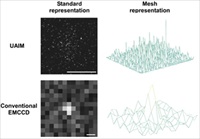Members Login

Channels
Special Offers & Promotions
Andor EMCCD camera delivers Ultrahigh Accuracy for Super Resolution Microscopy
Ultrahigh accuracy imaging modality (UAIM) technique provides more than 200% accuracy improvement compared with conventional low-light imaging
 Super resolution localization microscopy techniques, which allow the capture of images with a higher resolution than the diffraction limit of approx. 250 nm, are breaking new ground in our understanding of subcellular structures and the movement of individual molecules within cells. However, the positional accuracy attained by these powerful techniques has been limited by the pixelation and noise generated by CCD and EMCCD detectors.
Super resolution localization microscopy techniques, which allow the capture of images with a higher resolution than the diffraction limit of approx. 250 nm, are breaking new ground in our understanding of subcellular structures and the movement of individual molecules within cells. However, the positional accuracy attained by these powerful techniques has been limited by the pixelation and noise generated by CCD and EMCCD detectors.
Now, a team from the University of Texas at Dallas led by Prof. Raimund J. Ober has discovered a method to almost eliminate these two image-deteriorating factors and improve parameter estimation accuracy by more than 200 percent. Publishing in Nature Methods, they used an Andor iXon3 897 EMCCD camera to present the Ultrahigh Accuracy Imaging Modality (UAIM).
"UAIM uses the EMCCD camera to its fullest potential, beyond what is commonly believed to be possible by the scientific imaging community," says Prof. Ober. "Specifically, our results show that when an average of less than one photon is detected per pixel, the excess noise due to the camera's electron multiplication process is reduced to such an extent that an accuracy can be obtained that approaches the absolute best accuracy attainable only with an imaging detector that neither pixelates nor adds measurement noise to the image data.
According to Colin Coates of Andor, "UAIM uses the iXon3 EMCCD detector at a high level of signal amplification and in a highly unconventional and counterintuitive setting in which the number of photons detected in each pixel of an acquired image averages less than one. The resulting image does not give a visually clear representation of the object of interest as might be expected for obtaining high localization accuracies but, significantly, this new imaging method is applicable to all types of estimation problems. Although Prof. Ober and his team UAIM using single molecule localization, it can be applied equally to other EMCCD imaging applications, for example in astronomy, surveillance and machine vision."
Media Partners


